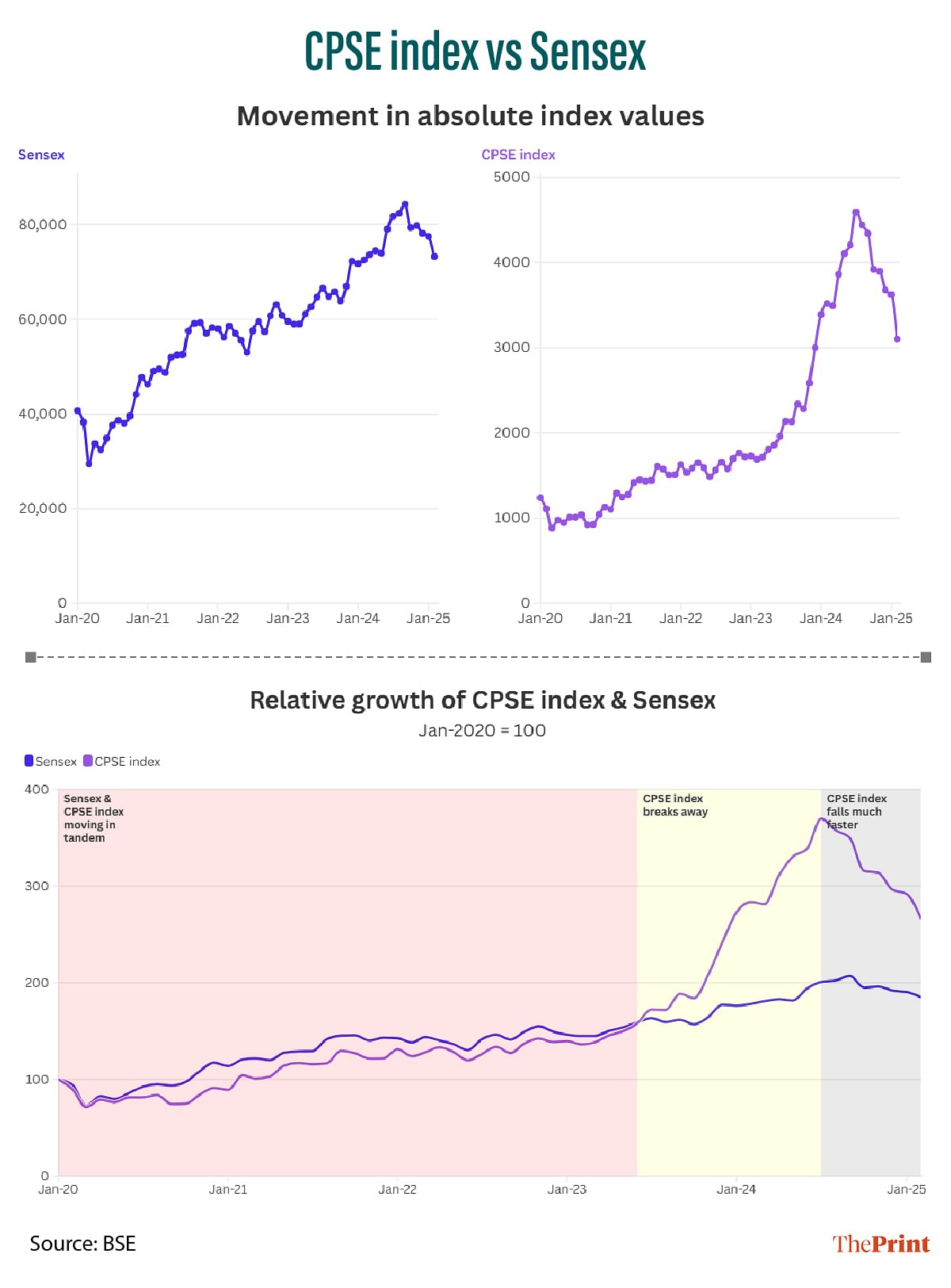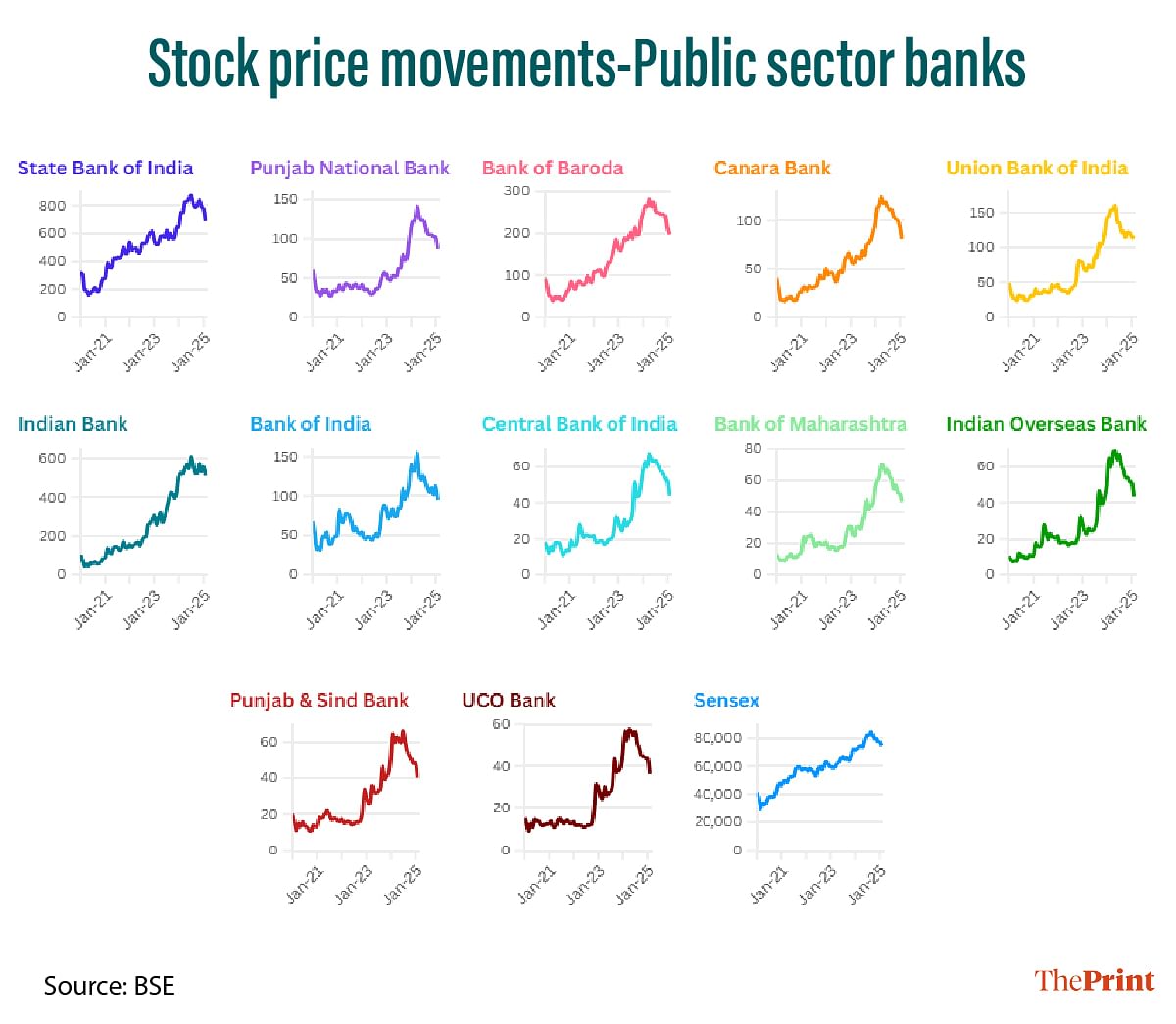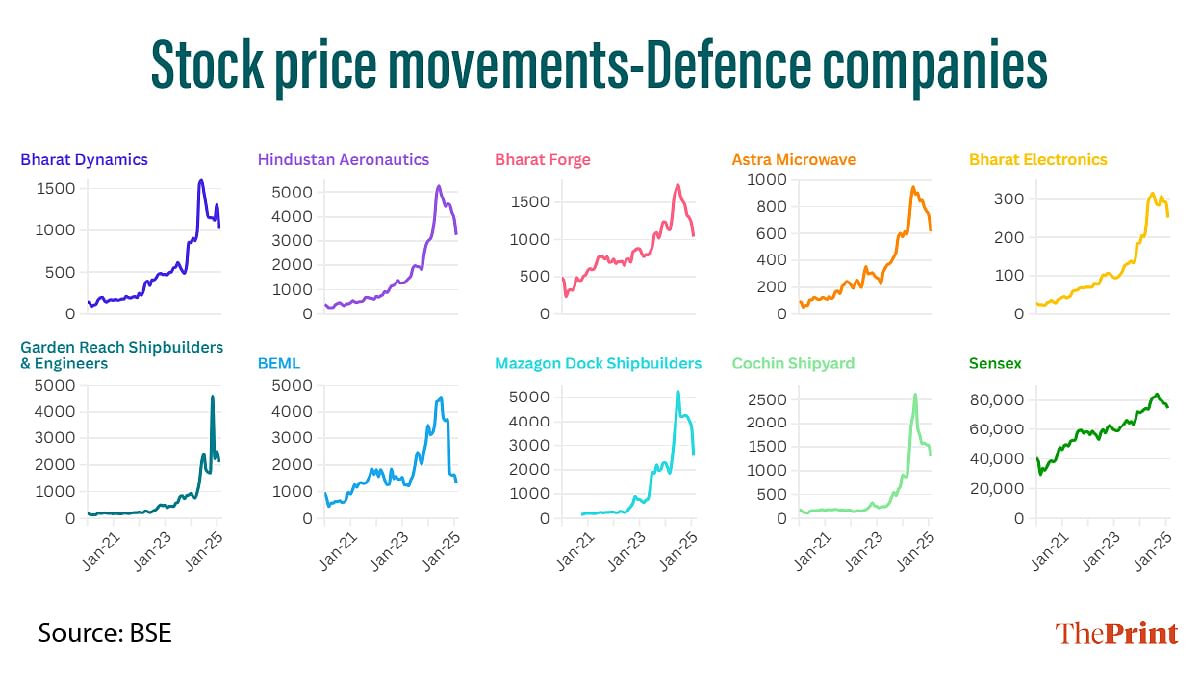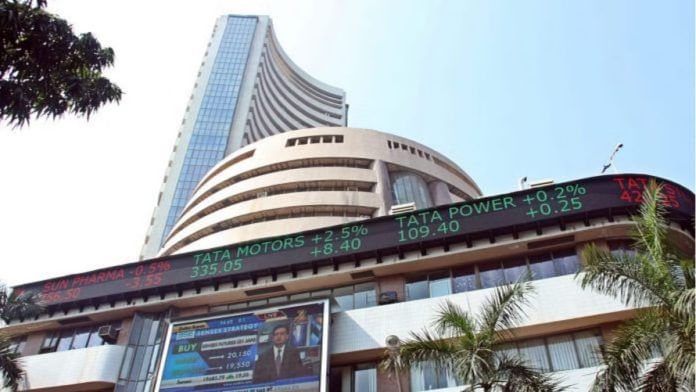New Delhi: Once the favourites of new-to-the-market stock investors, India’s listed public sector companies’ stocks have now fallen about 30 percent from their peaks last year—far more than the overall Sensex, which has fallen about 13 percent in the same period.
This has also put a significant dent in the market capitalisation of these government-owned companies, to the tune of Rs 13 lakh crore. In other words, public sector companies saw one-fifth of their market cap erased in just a few months.

This exaggerated fall represents a reversal of the sentiment-driven meteoric rise these stocks experienced throughout 2023 and much of 2024. It marks a return to reality as the government’s narrative on capital expenditure shifted and the true picture of underlying businesses in sectors such as banking and shipbuilding became apparent.
In total, the listed public sector companies, including banks and insurance firms, have seen their market cap fall from Rs 67.04 lakh crore in mid-October 2024 to Rs 54.13 lakh crore as of 28 February 2025—a nearly 20 percent decline.
Also Read: RBI projects 6.7% growth for FY 26 on better Rabi harvest, tax relief by govt
The blistering growth of CPSE stocks
The post-pandemic period saw remarkable growth for India’s stock market, with the Sensex rising nearly 60 percent between January 2020 and June 2023.
During this period, the CPSE index of the Bombay Stock Exchange—which captures the stock prices of listed non-financial public sector companies—grew in tandem. That is, it also increased by nearly 60 percent between January 2020 and June 2023.
However, here is where the trajectories of these two indices diverged. Over the next 15 months from June 2023 to September 2024, the Sensex grew a further 30 percent. In contrast, between June 2023 and July 2024, a one-year period, the CPSE Index skyrocketed by 134 percent.
In February 2024, ThePrint had reported on this emerging trend and found that the government’s Make in India initiative, coupled with its infrastructure focus, had led to a surge in new orders for public sector companies across industries such as power, roads, rail, and construction, apart from railways, shipping, and defence.
What also became evident at the time was the influence of narratives and sentiments in driving up the stock prices of public sector companies. The prevailing belief was that as the government’s policies played out, these companies would continue receiving orders and growing.
“An interesting trend in the rally that took the Nifty from 7,511 in March 2020 to 26,277 in September 2024 was the excellent performance of PSUs like public sector banks and railway and defence stocks,” VK Vijayakumar, Chief Investment Strategist at Geojit Financial Services, told ThePrint.
In May 2024, Finance Minister Nirmala Sitharaman also spoke about how the market capitalisation of public sector companies had grown “225 percent in three years”.
The rug gets pulled from this growth story
After July 2024, something changed in the market’s sentiment towards public sector stocks in particular and the stock market in general.
As of the end of February 2025, the BSE CPSE Index has fallen nearly 30 percent from its peak in July 2024. In contrast, the Sensex peaked in September 2024 and has fallen about 13 percent since then.
“Sectoral churns take place in the market every year,” Vijayakumar explained. “Market leaders change. In the correction that happened after the September peak, these segments, particularly railway and defence stocks that had risen too much, too fast, saw huge corrections, with some shipping stocks like Cochin Shipyard crashing 50 percent from their peak.”

This decline, too, was something ThePrint had reported on earlier as the trend was emerging. For example, in October 2024, it reported how public sector bank stocks had taken a beating, falling 20–30 percent from their peaks as the reality of falling profitability dented the prevailing narrative that public sector banks were thriving.
At the time, Mumbai-based fund management firm Carnelian Asset Management & Advisors had written a letter to its investors warning about the dangers of narratives in the stock market, with public sector banks being one of the affected sectors.
“As a narrative gathers steam, it can go far and wide, reaching a level of contagion,” the letter stated. “At this point, intrinsic values and market prices diverge, making an investment opportunity either too lucrative or too expensive. Hence, avoiding this becomes very important.”
This trend has since intensified, with several public sector bank stocks now down nearly 40 percent from their peaks.
Construction and defence stocks are also hurting
The other sectoral victims of changing narratives and shifting government focus were the defence and construction sector stocks.

Defence stocks, particularly those receiving shipbuilding orders, have fallen between 20–60 percent since their peaks last year. For example, Cochin Shipyard has seen its stock price decline by 52 percent since July 2024, while Mazagon Dock Shipbuilders has suffered a 59 percent drop.
Garden Reach Shipbuilders & Engineers saw its stock price fall about 47 percent since July 2024.
The reason for this decline is the same as in October 2024—new investors, buoyed by the government’s Make in India announcements for the defence sector, were now facing the reality of project delays and falling profitability.
Another likely factor at play, according to stock market analysts, is the government’s policy shift regarding capital expenditure. In the post-pandemic period, the government had increased its capital expenditure by an average of 30 percent per year between 2021–22 and 2023–24. This was what had driven the surge in orders for construction and railway companies.
However, in her July 2024 budget for the financial year 2024–25, Sitharaman announced that capital expenditure for the year would increase by only 11 percent compared to what was budgeted for 2023–24.
While the Finance Minister did state that the government would provide fiscal support for infrastructure creation, she added a caveat that this would be “in conjunction with imperatives of other priorities and fiscal consolidation”.
This year, too, Sitharaman announced only a minor increase in the government’s capital expenditure budget—just a 0.9 percent rise over what was budgeted the previous year.
Analysts ThePrint spoke to said that this policy shift has significantly dampened the spirits of investors who were previously gung ho about infrastructure stocks.
(Edited by Radifah Kabir)
Also Read: India’s Q3 economic growth comes in at 6.2%, with agriculture outpacing manufacturing sector







Welcome to extreme left wing, government occupying commanding heights of economys Modi Raj.
Wholesale disinvestment is the need of the hour. These babus will never mend their ways. Most of these babus are from the Hindi heartland of Bihar, UP, Haryana, MP and Rajasthan. They bring their regressive culture to these organizations which includes a pathetic work ethic. These entitled babus would not last a day in the private sector.
Wholesale privatization is the need of the hour. The Modi government must not be afraid of employee unions.